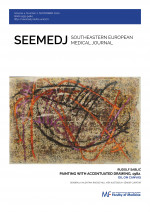Experimental Liver Peroxidation on the Background of Limb Ischemic-Reperfusion Injury – Is There Pathogenic Difference Between Its Modifications?
DOI:
https://doi.org/10.26332/seemedj.v4i2.135Ključne riječi:
ischemia-reperfusion syndrome;, liver; blood loss; , tourniquet; , lipid peroxidationSažetak
Introduction: Use of the haemostatic tourniquet is an important step in providing first aid in open bleeding injuries. Tourniquet pressure on the extremity triggers local lipid peroxidation. However, the systemic influence of tourniquet thereof has not been fully studied.
Aim: This study aimed to evaluate the changes that occur against the background of ischemia-reperfusion syndrome (IRS) and modifications of trauma in the main gland for detoxification – the liver.
Materials and Methods: In order to estimate the liver condition under the effects of a haemostatic tourniquet, animals were divided into 5 experimental groups, where modifications of hypoxia were performed as a result of bleeding, IRS and trauma due to mechanical fracture of the thigh.
Results: Biochemical study of the liver has shown that each type of such interventions caused the activation of lipid peroxidation in this organ. The highest increase of the malonic dialdehyde rate was observed in response to haemostatic tourniquet combined with blood loss. Additionally, its content was higher in the group combining mechanical trauma and the tourniquet compared to isolated trauma.
Conclusion: All types of our interventions caused hypoxia – as a result of isolated bleeding and cessation of blood flow due to the tourniquet. However, the release of overconcentration of toxic derivatives of rhabdomyolysis, which entered the blood stream after limb release, activated the pathological mechanisms of IRS, which included intensified lipid peroxidation in the liver.
Preuzimanja
Objavljeno
Broj časopisa
Rubrika
Licenca
Autorska prava (c) 2025 Southeastern European Medical Journal

This work is licensed under a Kreativni Commons Attribution-NonCommercial-NoDerivatives 4.0 International License.



